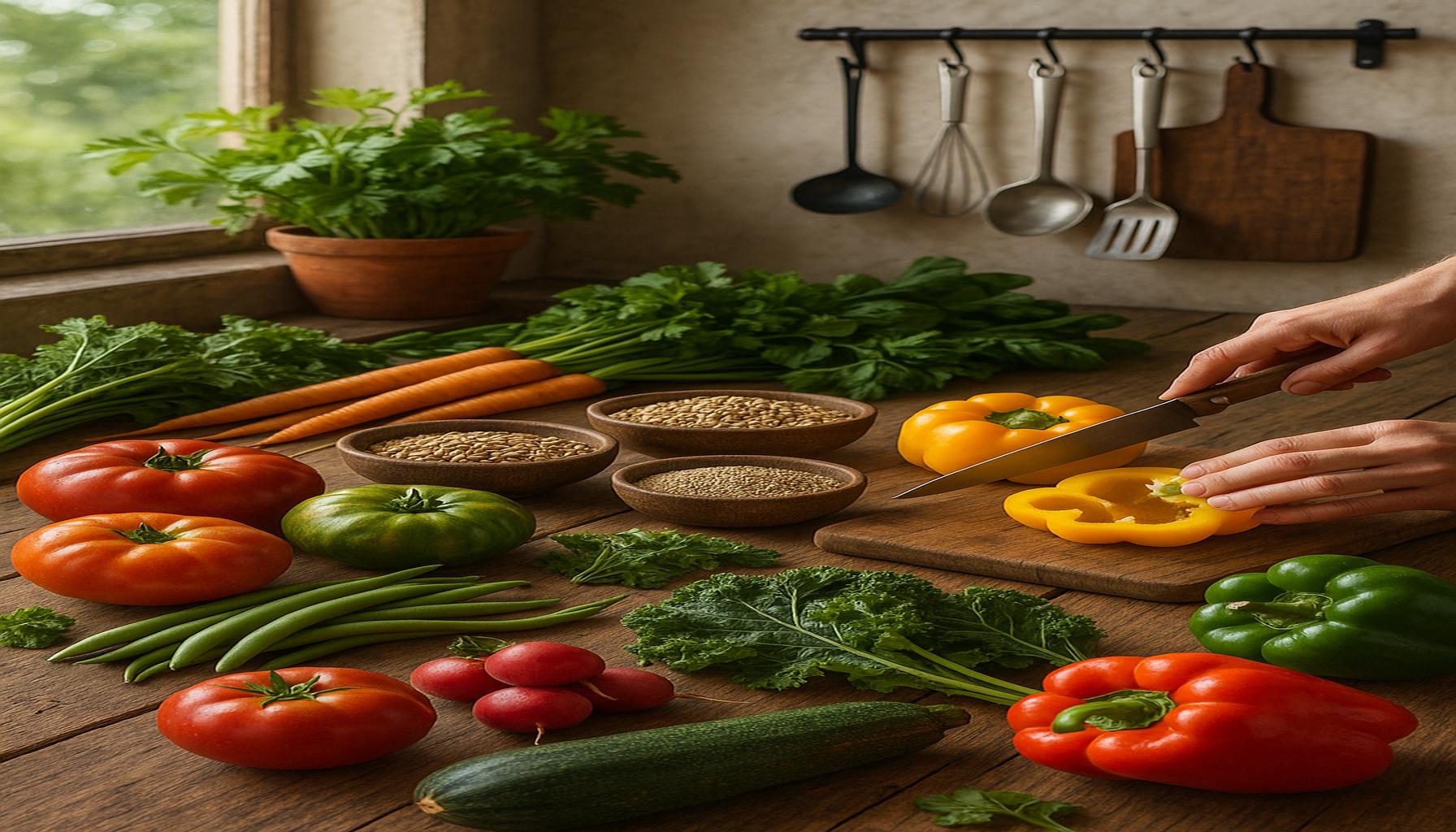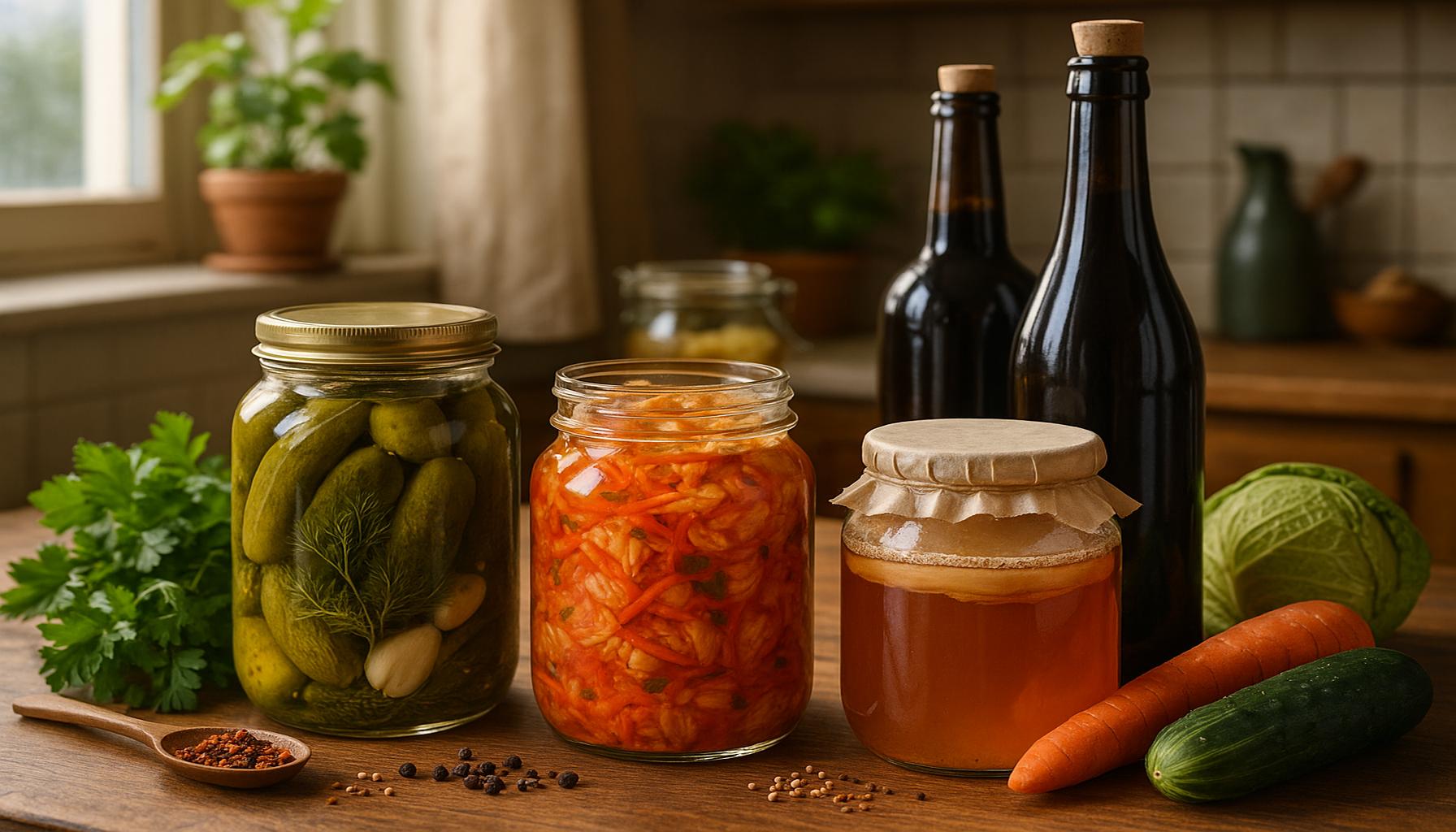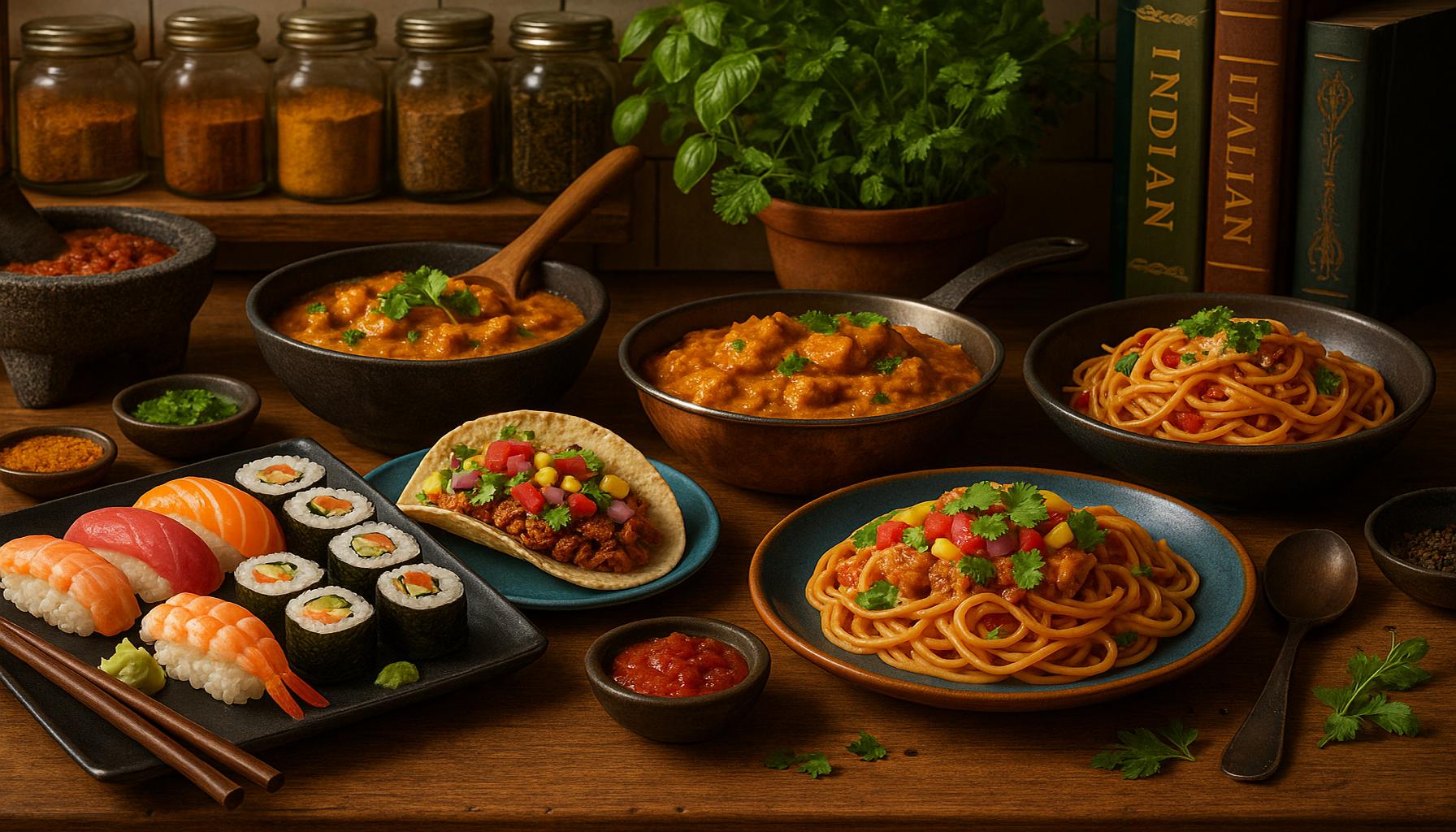Sustainable Cuisine: Delicious Recipes with Local and Organic Ingredients

Understanding the Impact of Food Choices
As society evolves to face pressing environmental challenges, sustainable cuisine emerges not merely as a culinary fad but as a profound commitment to healthier living and environmental stewardship. It calls for a deliberate choice to prioritize local and organic ingredients, bridging the gap between food, community, and ecosystem health. Engaging with this way of cooking not only delights the palate but also aligns eating habits with a larger purpose—supporting local farmers, reducing ecological footprints, and enjoying fresher produce.
Why Choose Sustainable Cuisine?
- Health Benefits: The use of organic ingredients means meals are free from synthetic pesticides and fertilizers. This not only leads to better nutrition—due to higher levels of vitamins and antioxidants—but also minimizes exposure to harmful chemicals. Research shows that organic produce can have up to 70% more antioxidants compared to conventionally grown counterparts, enhancing overall health.
- Environmental Impact: Sourcing food locally significantly cuts down on greenhouse gas emissions as it reduces the need for transportation. Food that travels less than 100 miles from farm to table not only tastes fresher but directly supports local economies and creates a resilient food system. Additionally, by choosing to buy from local farmers, consumers are also promoting sustainable farming practices that maintain biodiversity.
- Seasonal Variety: Eating seasonally fosters a deeper appreciation for the rhythm of nature. Menus rich in seasonal ingredients invite diverse flavors and textures to our plates, from vibrant summer tomatoes to hearty winter squashes. This encourages creativity in the kitchen and aligns eating habits with what the environment naturally offers. For instance, embracing the fall harvest can lead to dishes brimming with pumpkins, apples, and root vegetables.
The increasing demand for transparency in food sourcing reflects a pivotal shift in consumer attitudes—one that prioritizes sustainability as a core value. This transformation is evident in the growing popularity of farmers’ markets, which are popping up in cities and towns across the United States. These markets serve as hubs for fresh produce, allowing consumers to interact directly with farmers, learn about their practices, and make informed purchasing decisions.
Exploring delicious recipes made with fresh, local ingredients reveals endless culinary possibilities. From a zesty heirloom tomato salad bursting with flavor to a robust vegetable stew that warms the soul during chilly winter months, sustainable cooking can enchant both novice cooks and experienced chefs. These recipes often emphasize simple techniques that highlight the innate qualities of seasonal produce, showcasing its freshness and flavor.
What to Expect
This article will delve into the art of creating delectable dishes using sustainable ingredients that promise to tantalize the taste buds. Readers will discover how to assemble vibrant salads, satisfying entrees, and even delightful desserts—all while reducing their environmental impact. The journey into sustainable cuisine is not just about cooking; it’s an opportunity to weave sustainability into the fabric of daily life, culminating in a healthier relationship with food and the environment.
DISCOVER MORE: Click here to learn how music can enhance your mental health
The Foundations of Sustainable Cuisine
At its core, sustainable cuisine celebrates a deep connection with our food—where it comes from, how it is grown, and who is involved in its production. By valuing local and organic ingredients, we not only enhance the culinary experience but also foster a deeper understanding of food systems and their impact on our health and environment. Such a culinary approach encourages cooks to seek out ingredients that are in alignment with seasonal practices, leading to a more vibrant diet and a more mindful kitchen.
Understanding the principles of sustainable cuisine can help elevate your cooking and dining experiences while addressing various ecological challenges. Here are some pivotal aspects to consider:
- Supporting Local Economies: By purchasing from local farmers and producers, you invest in your community and help sustain the livelihoods of those who grow your food. When you buy from farmers’ markets or local co-ops, you are contributing to a circular economy that minimizes the environmental costs associated with long-distance food transportation.
- Minimizing Food Waste: Sustainable cuisine encourages thoughtful planning and preparation, which are crucial for reducing food waste. With careful storage and meal planning, cooks can make the most of their seasonal ingredients, ensuring nothing goes unused. This mindfulness cultivates resourcefulness in the kitchen and can lead to innovative new recipes.
- Enhancing Flavor and Nutrition: Local produce is often picked at peak ripeness, allowing for the fullest expression of flavor. Moreover, organic methods minimize harmful additives, resulting in cleaner, healthier food. Consuming meals made from these ingredients fosters a greater appreciation for the food itself and invites culinary creativity.
- Environmental Conservation: Organic farming practices reduce reliance on synthetic fertilizers and pesticides, preserving soil health and promoting biodiversity. This not only benefits the environment but also promotes greater resilience within ecosystems, ensuring a sustainable supply of food for future generations.
As the rise in awareness regarding food sources continues, chefs and home cooks alike are turning to sustainable practices to provide a clearer path toward healthy eating. The advent of community-supported agriculture (CSA) programs has also played a pivotal role in connecting consumers directly with farm-fresh produce while expanding access to organic options.
From hearty grain bowls featuring seasonal vegetables to warming soups crafted from locally-sourced ingredients, the potential of sustainable cuisine is immense. Each recipe constructed within this framework tells a story of place, season, and community, and it has the power to transform the way we think about our meals. By prioritizing freshness and locality, one can develop engaging, nutritious dishes while championing the principles of sustainability.
Embarking on the Sustainable Culinary Journey
As we delve deeper into the world of sustainable cuisine, we will explore a variety of delicious recipes that embrace local and organic ingredients. Readers will learn how to navigate flavors that not only respect the environment but also tantalize the taste buds. In the following sections, be prepared to embark on a culinary journey that showcases the essence of sustainable eating—where every bite contributes positively to our health and our planet.
| Advantage | Description |
|---|---|
| Freshness of Ingredients | Utilizing local produce ensures maximum freshness, enhancing flavor and nutritional value. |
| Environmental Impact | Choosing organic ingredients reduces carbon footprints associated with transportation and synthetic pesticides. |
| Community Support | Purchasing from local farmers strengthens local economies, fostering a sense of community and sustainability. |
Delving into “Sustainable Cuisine” reveals that using local and organic ingredients brings forth a multitude of benefits. One major advantage lies in the freshness of ingredients. By sourcing from local farms, you’re not only supporting your region but also ensuring that your meals are crafted from produce at its peak ripeness. This leads to an explosion of flavor and an overall enhancement in the nutritional profile of your dishes.Beyond flavor, there’s a significant environmental impact to consider. Embracing organic ingredients minimizes the reliance on harmful pesticides and synthetic fertilizers, contributing to healthier ecosystems. This approach directly reduces carbon footprints related to transporting goods over long distances. Moreover, engaging with local farmers fosters a sense of community. When you support local agriculture, you’re not just making a purchase; you’re investing in the strength and vitality of your community. This practice nurtures bonds between producers and consumers, encouraging a culture of sustainability that can flourish over time.
DIVE DEEPER: Click here to uncover watercolor techniques
Exploring the Wholesome Ingredients of Sustainable Cuisine
Embarking on a journey into sustainable cuisine means embracing a diverse array of ingredients that speak to the seasonality and geographical uniqueness of our dining experiences. Imagine strolling through a vibrant farmers’ market, where the produce glistens under the sun, and the aromas of fresh herbs captivate your senses. Here, you can cultivate an intimate understanding of the ingredients that fuel your creativity in the kitchen. Let’s delve deeper into the types of local and organic ingredients vital for crafting mouthwatering dishes.
1. Seasonal Vegetables: One of the most powerful aspects of sustainable cuisine lies in harnessing the flavors of seasonal vegetables. From the peppery bite of arugula in spring to the hearty sweetness of squash in autumn, seasonal vegetables add depth to any meal. Growing seasons can differ from one region to another, leading to unique culinary practices across the United States. For instance, tomatoes grown in California receive plenty of sunny days, offering robust flavors that can transform any simple dish into a gourmet experience.
2. Grains and Legumes: Who can resist the wholesome goodness of grains? Local farmers often cultivate a variety of grains that lend themselves beautifully to a sustainable kitchen. Quinoa, farro, and brown rice not only provide sustenance but also create a delicious base for salable salads, grain bowls, and side dishes. By incorporating beans and lentils, you can enrich your meals with protein while simultaneously reducing overall environmental impact. Notably, combining these plant-based proteins with fresh herbs and vegetables creates balanced and nutritious offerings that honor both taste and health.
3. Regional Proteins: When it comes to animal proteins, choosing meat, poultry, and fish that are responsibly raised and sourced can make a substantial difference. Organic farms often focus on sustainable livestock practices, which ensure that the animals are well cared for and fed a natural diet. By opting for grass-fed beef or free-range chicken sourced locally, you not only support ethical farming but also enjoy meat that is filled with flavor. Moreover, many coastal communities in the U.S. offer access to wild-caught, locally-sourced fish, which often have a lower carbon footprint compared to farmed options.
4. Artisan Products: Sustainable cuisine also embraces local artisans who produce a range of delectable goods, from cheeses and charcuterie to preserves and breads. These products are often crafted with raw, organic ingredients and reflect authentic regional flavors. Exploring local dairies for artisanal cheese or seeking out bakeries that utilize whole grains can enhance your meals and inspire creativity in the kitchen. Think outside the box—imagine a vibrant bruschetta topped with locally-made cheese and seasonal tomatoes, or a charcuterie board that showcases the best of local flavors.
5. Foraged Ingredients: Lastly, foraging can be an exciting way to engage with sustainable cuisine. Learning to identify and gather wild edibles like ramps, dandelion greens, or wild mushrooms can bring a unique flair to your dishes. Foraging not only allows you to connect with nature but also brings an element of adventure to the table. It’s crucial to educate yourself about safe foraging practices, and local guides can be a great resource for this journey.
With these wholesome ingredients at your fingertips, you can craft remarkable recipes that reflect the beauty of sustainable cuisine while engaging your senses and nourishing both body and soul. In the next section, we will dive into specific recipes that highlight these ingredients and embody the principles of sustainability, shining a light on the creativity that awaits in your own kitchen.
DISCOVER MORE: Click here to learn about eco-friendly crafting
Embracing a Sustainable Culinary Future
As we stand at the crossroads of culinary innovation and environmental consciousness, the movement towards sustainable cuisine emerges as a beacon of hope, encouraging a deeper connection with the ingredients that grace our tables. By choosing local and organic ingredients, we not only elevate the flavors of our meals but also participate in a vital mission to support our local economies, reduce our carbon footprint, and promote biodiversity. The embrace of seasonal vegetables, wholesome grains and legumes, regionally sourced proteins, and artisanal products invites us to craft dishes that resonate with the rich tapestry of our communities.
Furthermore, considering the inclusion of foraged ingredients adds an element of adventure and a deeper appreciation for the natural world. The act of foraging teaches us about our local ecosystems, inspiring creativity and mindfulness in the kitchen, while connecting us with the land. This holistic approach to cooking not only nourishes our bodies but also cultivates a sustainable future for the next generations.
In essence, sustainable cuisine is more than a trend; it is a growing movement that invites all of us to rethink our food choices. By experimenting with delicious recipes rooted in local and organic ingredients, we honor the environment and our health. Let us continue to explore, innovate, and revel in the diverse flavors that nature offers, while celebrating the rich bounty of our own backyards. The next meal you prepare could be a step towards a healthier planet—one delicious bite at a time.


